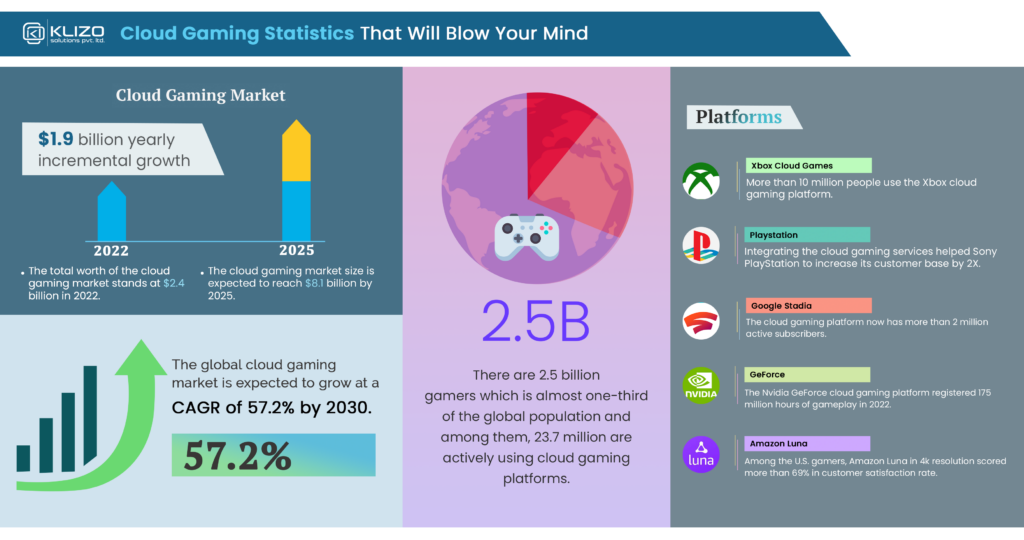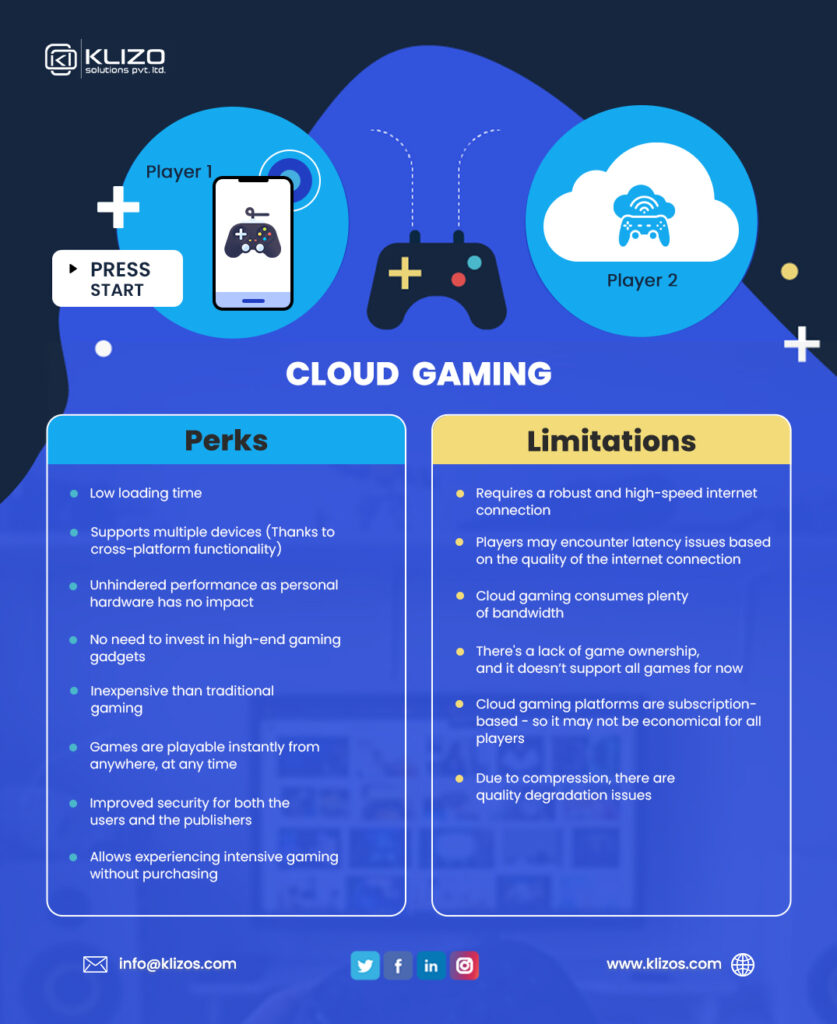


Hey, gamers! Ready to play the newest games on a range of devices from anywhere?
Thanks to cloud gaming, as long as you have a high-speed internet connection and a subscription with a cloud gaming provider, you’re all set for online gaming whenever you want and from any device!
Even if you’re not a gamer but a developer or a stakeholder in the gaming industry, cloud gaming is something you need to keep a tab on! After all, it is believed to be the future of the gaming industry!
Cloud gaming has been there since the late 2000s and has been competing with hardware-based computer games. But with the emergence of 5G and the advancement of technologies, cloud gaming is finally catching up!
Excited to know more about this “gaming as a service”? Then continue reading!
Cloud gaming, also known as game streaming or on-demand gaming, refers to games that run on a data server. Players can enjoy cloud gaming on their devices through remote accessibility. In cloud gaming, the processing is not done locally. And that is what differentiates cloud gaming from other games.
When players from different locations opt for cloud gaming, their input is sent to the cloud, processed there, and the output becomes visible to them in real time.
Cloud gaming works just the way a video streaming service or a remote desktop does. All it needs is a robust internet connection and a device, where the games can be played, and the user is all set!
Tech giants and providers of top cloud gaming services like Microsoft, Sony, Google, and Nvidia have already started investing in cloud gaming. And in the future, as per reports, the popularity of cloud gaming is only likely to increase and become a billion-dollar industry. As per reports, the global cloud gaming market is expected to reach $21,954 million by 2030!
What is the difference between traditional gaming and cloud gaming? The answer lies in where the computational heavy lifting takes place.
With traditional gaming, the gamer’s local hardware powers the computing required to run the game.
With cloud computing gaming, however, the gamer’s input is sent to a remote server, where it is processed. The gamers hardware then receives a video stream, which is displayed on the local device. And as a consequence, the most advanced games can be played on any device, capable of communicating with the server and displaying the video stream.
Imagine playing the most advanced games on your mobile device or a cheap old laptop without worrying about the hardware requirements or downloading the game.
Now, companies can leverage this technology to provide cloud gaming as a service, which is usually subscripted to every month. Users may choose a company and plan that offers a selection of games or purchase games individually. With cloud gaming, a gamer can access high-performance gaming, that too, without purchasing an expensive gaming console.
Investment from large tech companies and the continuous developments in infrastructure cloud network technology are, of course, two of the major driving factors behind the growing popularity of cloud gaming. But other than these, there are some other reasons which are very much valid and significant.
High-speed internet is necessary to stream high-resolution videos on a mobile device. With the advent of 5G networks, this is becoming more feasible. The ability to play games on mobile devices and tablets could prove to be a huge selling point for some cloud gaming companies. As the popularity of 5G grows, we can expect more users to opt for cloud gaming.
In cloud gaming, games are hosted in the cloud. Here, games do not depend on a specific local platform to run like traditional gaming. Whether cloud gaming android or cloud gaming iOS or playing it on computers, the users/consumers can play the same game across multiple devices. And this ensures the unbelievable potential for the stakeholders. Publishers can pay more attention to compatibility with only one gaming platform and engine.

Who wants to wait six hours for a game to download and install on a console or PC?
After all, the more convenient option tends to win. And with cloud gaming, a gamer can start playing those long-awaited new games in minutes, not hours, if a good internet speed is available.
Presently, we are used to waiting for games to install. The anticipation is more like a part of the fun for us. However, imagine when most of your friends switch to cloud gaming and want to get online in a game with you that you don’t currently have. What will happen then?
Won’t it be so tempting to buy a subscription on the spot than waiting for the game to get downloaded and then install it?
With cloud game development, players do not have to worry over how much free storage they have on their devices or keeping track of disks! With a fast internet connection, cloud gaming is a more convenient option in every scenario!
Imagine the challenge of bringing a new user into the market as a PC or console gamer. That is a tough job! Spending $500 on a gaming console or $1000 on a gaming PC is no small investment.
But what if the user already owned a device capable of cloud gaming? Even if they don’t, the price of getting into cloud gaming might be as little as less than $100 to purchase the controller. Some companies may even offer free hardware with the signing of a subscription.
Suddenly, the prospect of converting, for example, a mobile gamer to a high-performance gamer becomes much more readily available. When that friend, family member, or coworker asks to play their favorite game with them, there will be no more excuses! Another technique that companies may take advantage of to sell cloud gaming might be a referral program.
The prevalence of more and more devices used as a medium for cloud gaming also contributes to the growth of the gaming industry.
When the computing activity gets consolidated in the cloud, the computing power, along with the newest hardware, becomes available for cloud based game development. And this ensures the best in-game intelligence and graphics for the players that standalone hardware cannot meet.
One major hurdle for cloud gaming is internet speed. Cloud gaming needs a fast internet connection. For example, Shadow, one of the most expensive cloud gaming platforms, requires a minimum of 15Mb/s or greater bandwidth. A stable internet connection of 50Mb/s is preferred for the best experience.
Currently, many users in the United States have trouble meeting this need, which has led to many frustrated users being left with the memory of a bad experience.
However, we can expect that in the coming years, issues related to internet speed will get resolved as the internet speed improves. But then again, as internet speeds are increasing, the demand for higher and higher-resolution video streams is growing too!

Plus, latency is another issue inherent to cloud gaming technology.
As we know, the term refers to a time delay or the time taken by data to travel from the sender to the receiver. Now for cloud gaming, the input sign must make the trip instantly from your home to a server that might be hundreds or thousands of miles away. So, high-speed internet is a must for a seamless cloud gaming experience!
For now, cloud gaming is in a transitional phase. While core gamers may not need convincing about the perks of cloud gaming as it is likely to offer an upgrade to their present gaming experience, it may take more cloud gaming platforms and services to normalize this new way of gaming.
But then again, cloud gaming is here to stay and is getting popular and paving the path for a better future for the gaming industry. So, instead of waiting longer to get ready, jump on board into the new-world cloud gaming!
To stay informed about the latest and trending tech topics, stay tuned to our blog section! Share your take on cloud gaming in the comments section below!
And don’t forget that we not only write about advanced technologies but also help to build them! Contact us today for innovative tech solutions and professional app development services, no matter the niche your business belongs to!
Previous article
Joey Ricard
Klizo Solutions was founded by Joseph Ricard, a serial entrepreneur from America who has spent over ten years working in India, developing innovative tech solutions, building good teams, and admirable processes. And today, he has a team of over 50 super-talented people with him and various high-level technologies developed in multiple frameworks to his credit.

Subscribe to our newsletter to get the latest tech updates.